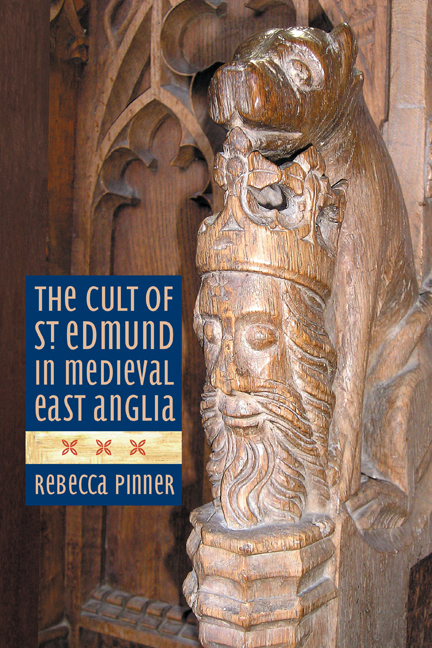Book contents
- Frontmatter
- Contents
- List of Illustrations
- Acknowledgements
- Abbreviations
- Introduction
- Part I Texts and Contexts: the Legend of St Edmund
- Part II Relics, Shrines and Pilgrimage: Encountering St Edmund at Bury
- Part III Beyond Bury: Dissemination and Appropriation
- Conclusion: ‘Martir, Mayde and Kynge’, and More
- Appendix 1 Synoptic Account of the Legend of St Edmund
- Appendix 2 Chronology of Significant Events and Texts Associated with the Cult of St Edmund
- Bibliography
- Index
Chapter 7 - The Devotional and Iconographical Context of the Shrine
Published online by Cambridge University Press: 21 May 2021
- Frontmatter
- Contents
- List of Illustrations
- Acknowledgements
- Abbreviations
- Introduction
- Part I Texts and Contexts: the Legend of St Edmund
- Part II Relics, Shrines and Pilgrimage: Encountering St Edmund at Bury
- Part III Beyond Bury: Dissemination and Appropriation
- Conclusion: ‘Martir, Mayde and Kynge’, and More
- Appendix 1 Synoptic Account of the Legend of St Edmund
- Appendix 2 Chronology of Significant Events and Texts Associated with the Cult of St Edmund
- Bibliography
- Index
Summary
The context of the shrine
WHATEVER its precise appearance, it is apparent that the shrine of St Edmund was significant in a number of ways in terms of projecting a particular version of Edmund's sanctity to pilgrims. It was the focus of cultic devotion and a means of displaying the wealth and prestige of the cult and the involvement of its important patrons. Its function as the container of the saint's remains, and the symbolic resonance of the materials from which it was constructed, also rendered it a potent object in its own right. The shrine, however, did not exist in isolation. Numerous objects commonly found in shrine chapels were present in the vicinity of Edmund's remains. Candelabra or tall candlesticks were usual, and the presence of the latter is attested at St Edmund's shrine by the annotations in College of Arms, MS Arundel 30 which refer to the ‘magno candelabro’. Four of the Harley 2278 miniatures likewise depict the shrine with a large candlestick at each corner (fols 4v, 9, 100v, 106). Hanging basins might provide additional light, but could also be receptacles for holy water or for the receipt of offerings. Books belonging to the shrine could be stored in chests or cupboards nearby, or chained, and at some shrines wooden tabulae (decorated panels) provided written or pictorial exposition of the life and miracles of the saint. Nilson concludes that the overall impression offered by a thriving medieval shrine ‘must have been one of sumptuous clutter’. However, features such as these, although undoubtedly contributing to the experience of a pilgrim to Bury, are for the most part generic and common to many great shrines and it is rather in the specific orchestration of the east end of the abbey church at Bury that most may be discerned about the convent's attempts to determine the reception of its saint by the medieval faithful.
The devotional context
A tract on the dedication of the altars, chapels and churches at Bury St Edmunds, along with details in the Bury Customary, both preserved in the Liber Albus, indicate that St Edmund's shrine was surrounded by a host of other relics and secondary altars.
- Type
- Chapter
- Information
- The Cult of St Edmund in Medieval East Anglia , pp. 138 - 166Publisher: Boydell & BrewerPrint publication year: 2015

